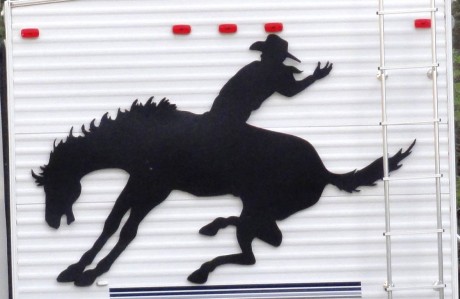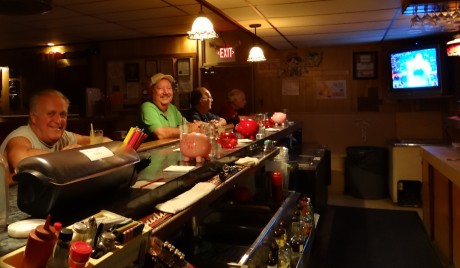Yesterday’s blog about Brownsville, I neglected to mention that the
city does not allow plastic bags. When you shop, you must bring your
own bag or carry purchases as they are. What a treat it is to visit an
area without plastic bags clinging to every alley, puddle, barbed- wire
fence and twiggy bush along the roadsides. Residents are aware of the
huge conglomeration of plastic bags that reaches the ocean and gets
caught in a swirling ocean vortex often described as the size of the
state of Texas. In windy country like South Texas, that ban is very
meaningful. Thank you citizens of Brownsville.

From Brownsville, we drove North East along the coast. At one point a sign indicates -Sixty Miles To The Next Service Station. We figured we were probably driving across the King Ranch, or part of it. We saw a sign for Yburria Ranch, which is another huge ranch holder like King, Kennedy and others that acquired huge Spanish land grants at three cents an acre.
We parked at the Kingsville Elks Club #1226, then went to visit the Kings Ranch Museum. On the drive over, we noticed the King Ranch Saddle Shop. The museum doesn’t allow photos, but is beautifully done, and well worth seeing. A family history is shown in a 23 minute video of the family.
One grand-daughter climbed a tower in the 1940′s and took pictures of the cattle milling, the men working the cattle, and photos of life on the ranch. These photos blown up to one- story size are the centerpiece of the museum, viewable from below and a walkway above. Other, bigger than life photos and a ranch buggy and car collection take up most of the lower story. In the entrance, a rug depicting the King Family holdings that once covered a floor in their office buildings, is two stories high.
Richard King ran away from home at age 11 as a stowaway and ended up eventually in South Texas. A hard worker, he lived frugally. He met Robert E. Lee and Lee advised him to buy land and don’t ever sell. And, that is what he did. He bought the Santa Gertrudis land grant situated on a river. He went into Mexico just over the border from Brownsville and invited a whole village of people to move to his ranch and help him build it. They did.
I was impressed with King. He treated his help like family. They were family. They lived remotely and his children grew up side by side with his vaquero’s families. They ate the same food; he built a chapel and school for the children. And, some of the descendants of the vaqueros still work the King Ranch today. He dug wells and opened up the vast dry lands to productive pasture. He brought the first Brahma bull in to mix with his herd and began the Texas Long Horn tradition and better beef. There is much about this family you will like.
King died at age 60 of cancer and his wife and one son-in-law continued to build up the ranch. She lived to age 92, basically unchanged by wealth. Down to earth, hard-working, kind and helpful. Her daughter who succeeded her as matriarch of the family was the same. Subsequent generations have played with money, race horses, planes and politics. And, other businesses, like a dairy that produced 1000 pounds of butter a day. Saddles,a Hardware Store; they became growers with orchards of citrus and pecans. They employ a lot of people and own ranches in Australia, South America and one in Africa. They have become preservationists for wildlife on the ranch.
I especially enjoyed a beautiful saddle collection. One car in the collection had built in holsters in the metal to carry hunting rifles. There are several very original cars in this collection if you are a car collection addict.
From the King Museum, we learned we had passed by the Kennedy Ranch Museum at Sarita, in that wide expanse of “no services”.

Jim and I repaired to the Elks Club bar for a drink before dinner.

From Brownsville, we drove North East along the coast. At one point a sign indicates -Sixty Miles To The Next Service Station. We figured we were probably driving across the King Ranch, or part of it. We saw a sign for Yburria Ranch, which is another huge ranch holder like King, Kennedy and others that acquired huge Spanish land grants at three cents an acre.
We parked at the Kingsville Elks Club #1226, then went to visit the Kings Ranch Museum. On the drive over, we noticed the King Ranch Saddle Shop. The museum doesn’t allow photos, but is beautifully done, and well worth seeing. A family history is shown in a 23 minute video of the family.
One grand-daughter climbed a tower in the 1940′s and took pictures of the cattle milling, the men working the cattle, and photos of life on the ranch. These photos blown up to one- story size are the centerpiece of the museum, viewable from below and a walkway above. Other, bigger than life photos and a ranch buggy and car collection take up most of the lower story. In the entrance, a rug depicting the King Family holdings that once covered a floor in their office buildings, is two stories high.
Richard King ran away from home at age 11 as a stowaway and ended up eventually in South Texas. A hard worker, he lived frugally. He met Robert E. Lee and Lee advised him to buy land and don’t ever sell. And, that is what he did. He bought the Santa Gertrudis land grant situated on a river. He went into Mexico just over the border from Brownsville and invited a whole village of people to move to his ranch and help him build it. They did.
I was impressed with King. He treated his help like family. They were family. They lived remotely and his children grew up side by side with his vaquero’s families. They ate the same food; he built a chapel and school for the children. And, some of the descendants of the vaqueros still work the King Ranch today. He dug wells and opened up the vast dry lands to productive pasture. He brought the first Brahma bull in to mix with his herd and began the Texas Long Horn tradition and better beef. There is much about this family you will like.
King died at age 60 of cancer and his wife and one son-in-law continued to build up the ranch. She lived to age 92, basically unchanged by wealth. Down to earth, hard-working, kind and helpful. Her daughter who succeeded her as matriarch of the family was the same. Subsequent generations have played with money, race horses, planes and politics. And, other businesses, like a dairy that produced 1000 pounds of butter a day. Saddles,a Hardware Store; they became growers with orchards of citrus and pecans. They employ a lot of people and own ranches in Australia, South America and one in Africa. They have become preservationists for wildlife on the ranch.
I especially enjoyed a beautiful saddle collection. One car in the collection had built in holsters in the metal to carry hunting rifles. There are several very original cars in this collection if you are a car collection addict.
From the King Museum, we learned we had passed by the Kennedy Ranch Museum at Sarita, in that wide expanse of “no services”.

Jim and I repaired to the Elks Club bar for a drink before dinner.
No comments:
Post a Comment